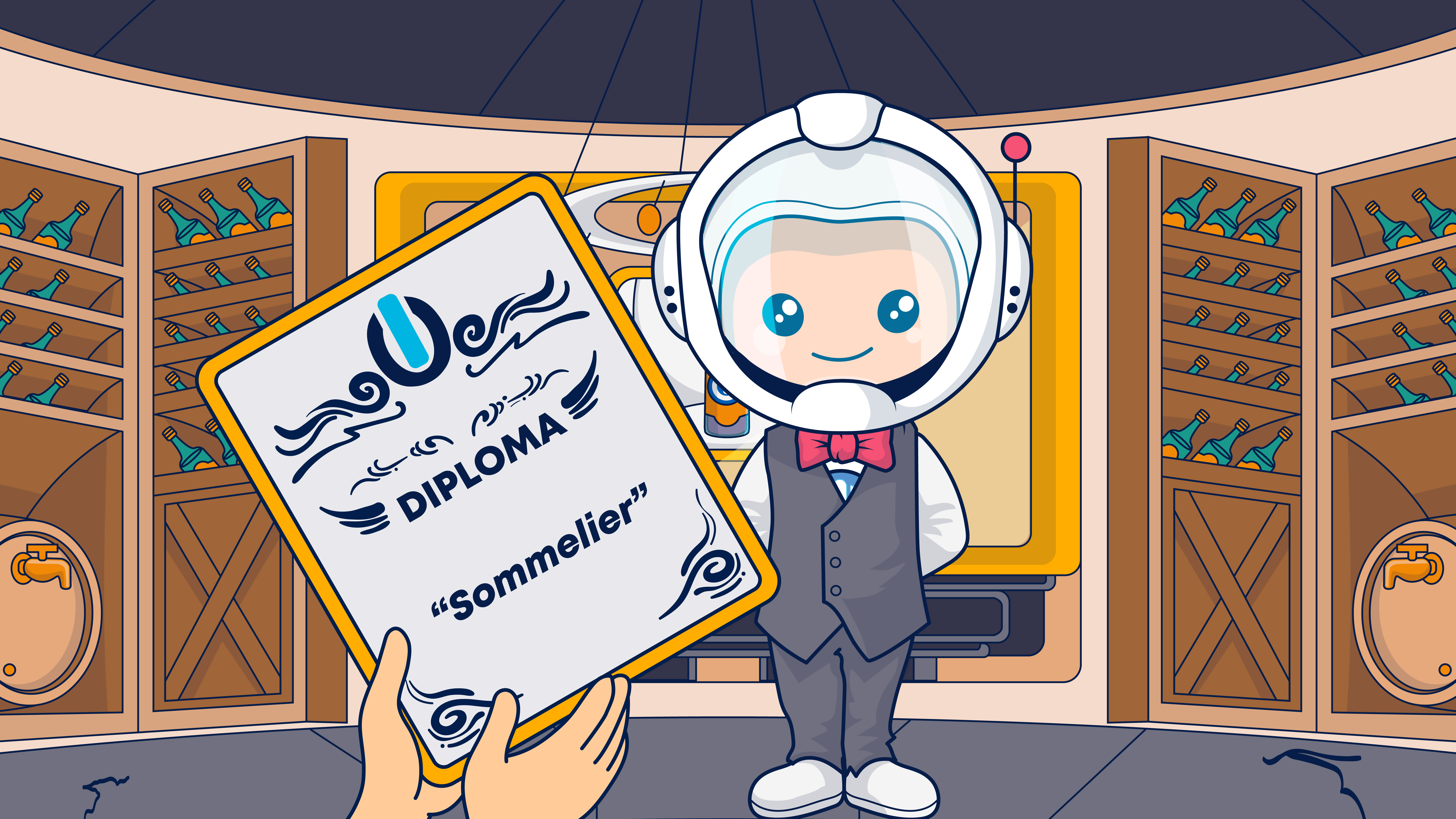Product recommendations are a standard feature on most ecommerce websites where they help visitors find what they want and discover new items to purchase. But your brand doesn’t have to wait until someone visits your website to unleash the power of product recommendations. Increase your website traffic and sales and enhance your customers’ experiences by sending value-adding, conversion-focused product recommendation emails straight to your subscribers’ inboxes.
Email is a top marketing channel for many B2B, B2C, DTC, and other product sellers because it enables organizations to reach prospects and customers affordably and at scale.
Brands also value email’s flexibility.
No matter where someone is in their buyer’s journey, there’s an email campaign that can add value and momentum.
Among the emails businesses use to maintain their pipeline momentum are recommendation emails.
Product, resource, and service recommendation emails:
- Help potential customers find the products or services that solve their problems.
- Delight them with discoveries of things they didn’t know they wanted or needed.
- Guide subscribers toward placing their first order.
- Remind customers to repurchase their favorites.
- Encourage purchasers to upgrade their subscriptions.
- Introduce customers to new products or services to try.
- Build credibility, loyalty, and trust by offering valuable advice.
Whether your emails contain curated lists to guide shoppers collectively or personalized lists that provide one-to-one advice at scale, recommendation emails can increase your click-through and conversion rates and strengthen your customer relationships.
Come with me to discover how to use recommendation emails to put the power of suggestion to work for your brand.
And if you’re looking for other inspiring newsletter examples, be sure to check out our article on the subject, which contains 29 examples from leading brands.
What are product recommendation emails?
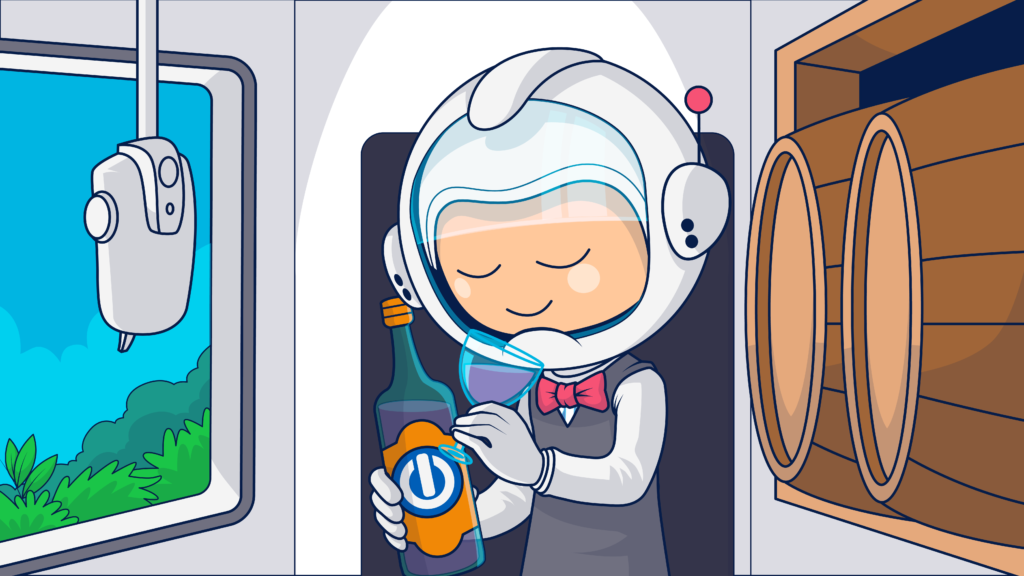
Product or service recommendations are commonly offered in online and offline environments to help customers make better choices faster.
We see product recommendations on businesses’ websites and digital ads, and physical store displays. Shopping assistants, in-person and online, make recommendations based on what they learn about their customers.
Recommendations for products or services are often tailored to a particular individual or group and are useful for nudging buyers to take the next step on their path to purchase.
Product recommendation emails are like digital catalogs that businesses deliver straight to their prospects’ inboxes. Recommendation email campaigns support product discovery and sales by introducing an intentionally selected set of products to email recipients.
Where do the product suggestions for a product recommendation email come from?
The recommendations included in email campaigns may be general or personalized, and senders may manually select the items to recommend or generate them using a product recommendation system or recommendation engines.
Some product recommendation emails are behavior-based, using behavioral targeting to send subscribers recommendations in response to their actions on the sender’s website or engagement with the sender’s emails. Other recommendation emails are part of single or ongoing campaigns.
Ecommerce platforms often include general and customizable product recommendation engines as part of their services to sellers. Brands may also develop their own recommendation engines or use a third-party system to generate product suggestions.
Recommendation engines use global and individualized data to make their picks, including group behaviors, peer selection, and personal behavior.
Automated recommendation tools such as Retail Rocket and SmartHint allow sellers to designate the criteria to use when making recommendations.
These include a visitor’s browsing or purchasing history as well as demographic attributes drawn from a CRM or other data source. Brands can also generate lists based on aggregate data such as a product’s attributes, customer ratings, or sales volume.
When setting their suggestion criteria, sellers can include exclusions or exceptions as well. For example, a brand might set a minimum in-stock threshold to avoid recommending items that may not be available by the time a subscriber responds to the email.
You don’t have to use an algorithm to make suggestions in your emails, though.
Manually built bulk or generic recommendations such as “Top seller” or “Staff favorite” lists are a valuable tool for introducing subscribers to the products that you want them to see.
Brands often use these types of product recommendation emails to gain data about subscribers’ interest in new products, move overstocked merchandise and encourage sales of premium items.
Do B2B, SaaS, and businesses offering information-based products or services use recommendation emails?
Messages that promote physical consumer goods are among the most common types of recommendation emails. This is a carry-over from the original source of product recommendations–websites, where B2C recommendations are pervasive.
However, brands that offer consumer or business services or information-as-a-service businesses such as job search, news, and education websites use recommendation emails, too.
Recommendation emails are an excellent tool to provide new users with a list of getting-started resources or suggest expansions or additional features that can improve their experience.
These types of recommendations enable B2B marketers to personalize and customize their appeals to prospects.
B2B buyers expect businesses to use the data obtained from them to customize buyer experiences and personalize product recommendations for faster, more convenient service.
How do brands benefit from using product recommendation emails?
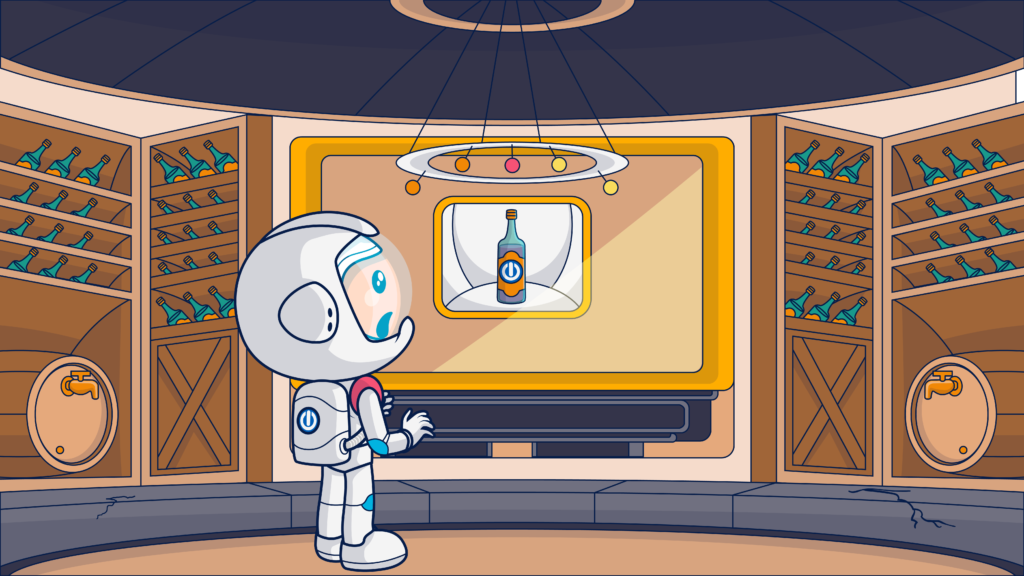
Product recommendation emails enable businesses to lend their knowledge and expertise to help subscribers achieve their goals and solve their problems.
If you’ve ever had the opportunity to enjoy a meal accompanied by a wine selected by a talented sommelier, then you know that the advice of an expert can dramatically enhance your dining experience.
Sommeliers bring their passion for and knowledge of wine to the table, literally, to ensure that you achieve the best pairings of food and spirit.
Receiving useful recommendations, whether for the right wine to accompany your meal or the right pair of running shoes for your running style, enhances consumer experiences.
Instead of having to research and evaluate every option alone, shoppers can tap into someone else’s knowledge. This speeds up their decision-making process and bolsters their confidence in the choices they’ve made.
No one wants to be embarrassed by making a bad wine choice when on a date or entertaining colleagues or clients. And no one wants to miss out on a better pair of shoes because they didn’t realize the store offered them.
Adding product recommendation emails to your marketing program increases your sales and reduces churn.
When customers have a positive experience before, during, and after their purchase, their relationship with your brand grows stronger.
5 ways product recommendation emails fuel growth by increasing revenue and customer loyalty
- Increased revenue. Recommendation emails generate engagement, click-throughs, and email conversions because they deliver timely, relevant content to your subscribers.
In a 2021 survey conducted by McKinsey & Co., 67% of consumers said that receiving relevant product or service recommendations influenced their decision to buy from a business for the first time.
Use list segmentation to target specific subscriber groups with bulk recommendations that match their stage in their buyer’s journey, demographic or psychographic attributes. Boost the relevance of your product recommendations by using a recommendation engine that selects items based on the individual subscriber’s behaviors or stated preferences.
- Shortened sales cycles. Consumers faced with a wide range of choices may not have time to evaluate them all or experience decision paralysis. This can result in them delaying or abandoning their purchase. Using your knowledge or machine learning to narrow their choices helps move them past this obstacle and toward finding what they want or need.
- Connected journeys. Refreshing your subscribers’ memories about their on-site shopping activities and providing them with relevant information to help them complete the process supports a singular, omnichannel experience that meets your customers where they are in the moment.
- Improved data. The click-throughs and conversions your recommendation emails generate (or don’t) is a valuable source of data about the segment and individual subscriber behaviors and preferences. Each new action contributes to better product development and promotion, and a more personalized experience for your subscribers.
- Increased customer loyalty. Recommendations that are useful or surprise and delight your subscribers build brand loyalty and trust. When the information you provide is useful, reliable, and helps people solve their problems, you become a resource, not just a retailer.
What kinds of product recommendation email templates should your brand develop?
Recommendations may be driven by the recommender’s goals or objective data, and sometimes by a combination of both.
For example, a brand might send a list of recommended holiday gifts several weeks before the start of the holiday shopping season to clear out excess inventory or to gauge demand.
Narrowing the list to include overstocked items that have been popular with consumers in previous seasons would add some objective data to the selection criteria (and make the results more relevant).
Recommendations based on knowledge and expertise, objective data, or customer feedback are likely to get a better response from your subscribers.
Get to know your subscribers and let them get to know you to build lasting, trust-based relationships that yield long-term benefits.
Prepare a series of product recommendation templates to achieve your business objectives and send the right message at the right moment to subscribers at various stages in their buyer’s journey.
Start building your email program’s recommendation pipeline with the following types of product recommendation email templates.
💬 Product-attribute recommendation email
Product-attribute recommendation templates may be personalized using merge tags to present suggestions that are similar to or complement something the subscriber has viewed or purchased in the past.
Non-personalized product-attribute recommendations enable brands to present a curated collection of related items based on the product’s attributes.
Recommendation emails in this category may include items that are visually similar or used for similar purposes. A product-attribute recommendation email’s theme might be “Complete the look,” “More items in your favorite color,” or “Snuggly warm casual wear for the whole family.”
Sometimes, an email may suggest alternatives to a product across different price points or other attributes or as a replacement for an out-of-stock item.
💬 Purchaser- or user-attribute recommendation emails
These recommendations may be created manually or machine-generated and are based on the purchasers’ or recipients’ traits rather than those of the product.
Some common examples in this category include emails with curated gift guides or products grouped by age, gender, or interests.
You can tailor these recommendations even further by segmenting your subscribers and customizing each segment’s recommendations.
💬 Seasonal or event-related recommendation emails
Holiday gift guides, summer apparel suggestions, and similar recommendations can nudge your subscribers to begin shopping for an upcoming holiday and highlight a selection of thematic products.
For instance, a retailer might feature pink products during Breast Cancer Awareness month or culturally relevant during National Hispanic Heritage Month or Black History Month.
Use recommendations in your holiday email marketing campaigns to help indecisive subscribers choose the perfect gift for loved ones or pick up a treat for themselves.
💬 Aggregate customer or popularity-guided recommendation emails
Recommendation engines can surface recommendations based on individual or aggregate behaviors. These recommendations use sophisticated algorithms and inventory tagging to go beyond just naming the top-selling items in a category.
The recommendations may be based on criteria such as:
- Which items shoppers frequently purchased together. Someone who purchased cat litter online might receive an email with a selection of cat toys or cat food recommendations.
- Recently popular products, or those that have been most often viewed, added to carts or wishlists, or purchased within a designated time period.
- The products website visitors tend to look at during the same browsing session. For instance, after viewing or purchasing an area rug, a subscriber might receive an email featuring lamps and throw pillows. A high-customization engine might suggest these items in coordinating colors and patterns.
- The item customers most often purchase after viewing a product category or specific product. An example of this type of recommendation would be an email with recommendations based on the winter coats most often purchased by other customers sent to someone who recently viewed winter outerwear on the brand’s website.
- The top converting products or those with the highest view-to-cart or view-to-purchase ratios. When people evaluate several products on your website, which ones do they eventually select for purchase?
- Which items have received high ratings or positive reviews from past customers?
- Signs that a product is up-and-coming or gaining momentum such as an uptick in recent views, positive reviews or ratings, or purchases.
💬 Hyper-personalized recommendation emails
Hyper-personalized recommendation emails use recommendation systems that employ algorithms, and sometimes machine learning, to make specific suggestions based on the individual recipient’s past behaviors and their stated preferences.
Customize blast emails or newsletters templates with dynamic email content that allow you to insert one-of-a-kind content into your messages at scale.
Take your relevancy up a notch by using triggered emails, such as an abandoned cart email or a post-purchase one, to deliver customized recommendations at just the right moment.
How to create personalized product recommendation emails?
Product recommendation emails may be personalized by segment or individual.
The recommendations that a brand sends to subscribers under age 25 might be different than those for subscribers who belong to an older demographic.
A B2B recommendation set or the copy that accompanies it might vary depending on the job title or position of the recipients.
Individual product, service, or resource recommendations may be developed using zero-party data that your subscribers provide to you about themselves. Another option is using observed data based on their interactions with your emails and online behaviors, such as their browsing history.
To implement this customization at scale, create product recommendation email templates that include dynamic fields to house data drawn directly from your CRM or other data sources, such as a customer’s name or hometown.
Then, use dynamic blocks to house product images drawn from your recommendation engine or another source. A dynamic block can be used to reserve space in your template for a real-time feed of new products, flight or hotel prices, or similar content.
Users of the Ongage email marketing platform have several options when it comes to inserting dynamic content and sending automated, event-triggered custom messages at just the right moment in each subscriber’s journey.
Speaking of timing. When should you send a recommendation email?
When is a good time to send a recommendation email?
Recommendation messages are an effective tool to introduce your brand and its products or services to new subscribers. Nurture new subscribers toward their first purchase and follow up with new customers post-purchase to expand the revenue you generate.
Use recommendations to enhance these lifecycle or event–triggered campaigns:
- Welcome emails
- Pre-purchase nurture series
- Save my cart reminders
- Recovery emails (browse, cart, sign-up or checkout abandonment)
- Win-back or re-engagement flows
- Order confirmation messages
- Delivery updates
- Post-purchase success and nurture campaigns (upsell, resell, cross-sell)
Add product emails into your scheduled campaigns and automated mail marketing flows when doing so meets your objectives and your subscribers’ needs.
Refer to your customer journey map to identify the points where a general or targeted recommendation will add value for your subscribers.
Slot recommendation emails into your regular and seasonal shopping mass email sends and newsletters using objective-based or themed lists. Send recommendations targeting distinct audience segments or distribute hyper-personalized suggestions using behavior-based targeting.
All right, enough theory! Want to see what some of these recommendation methods look like in practice?
Check out these real-world examples of recommendation emails that will guide your subscribers along their path to purchase and boost your revenue.
18 product recommendation email examples that earn subscribers’ confidence and clicks
📩 Price-based recommendation email from footwear and apparel brand UGG
UGG uses price as the common denominator in a general recommendation list that went out during the 2022 holiday season.
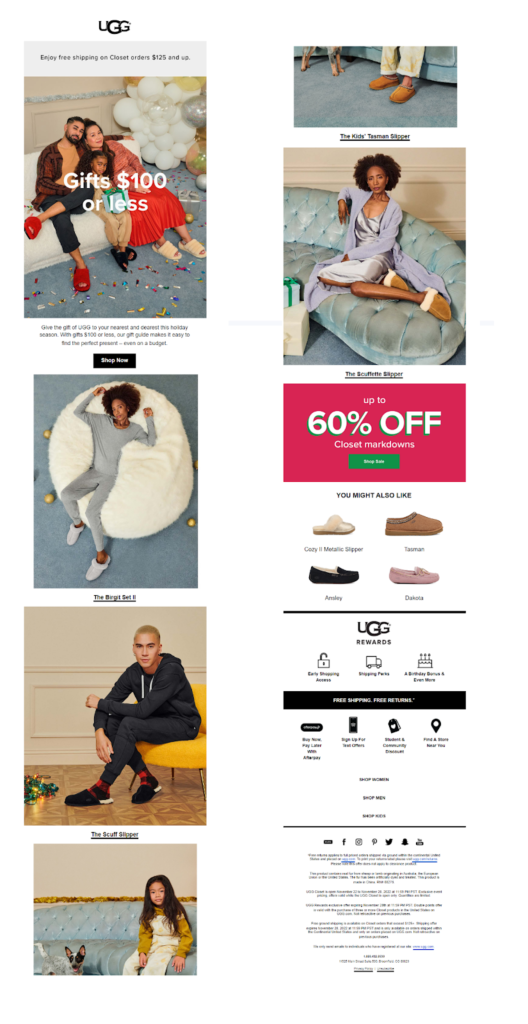
“Gifts $100 or less – Find something they’ll love”
Inside the email, images of models looking very comfy in their under $100 UGG slippers shows subscribers what they could buy for their loved ones or themselves.
📩 Recommendations sorted by popularity and history (time on site) for individual and business software conduit, AppSumo
AppSumo sends a weekly roundup newsletter to keep subscribers in the loop about the latest deals on this application aggregation site that serves both individuals and businesses.
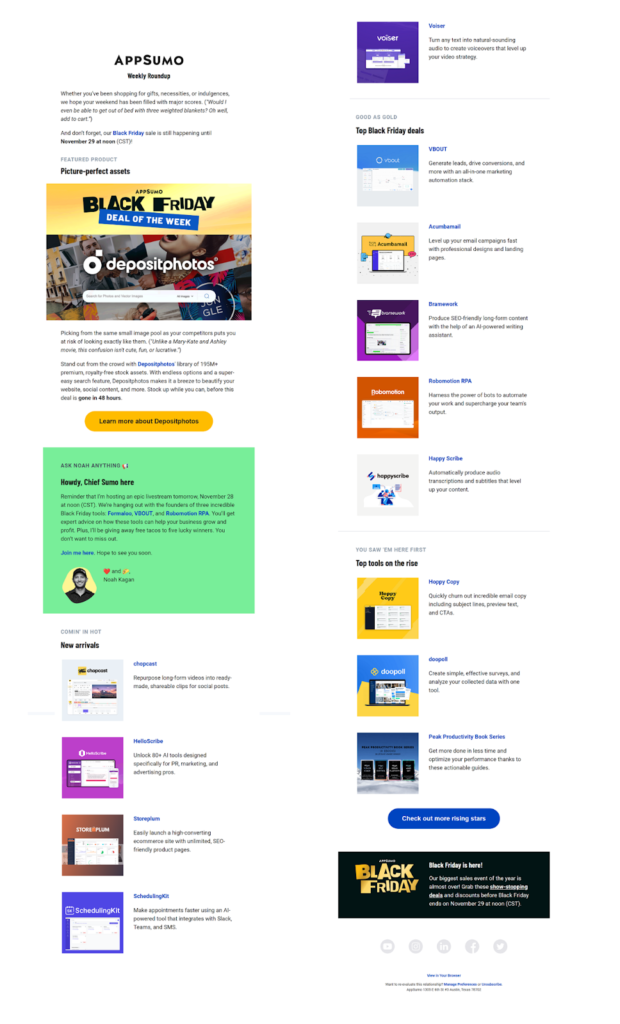
“Big picture thinking”
Separate recommendation sets include new arrivals, top deals, and exclusive sneak peeks under the heading, “You saw ‘em here first”.
(The subject line for this message, “big picture thinking,” is a reference to the featured product, Depositphotos.)
📩 General recommendation for seasonal selection from clothing brand Outdoor Voices
In an invitation to purchase cozy apparel gifts, Outdoor Voices presents a selection of top choices using animated GIFs. This allows the brands to squeeze multiple recommendations into the above-the-fold space in this promotional email.
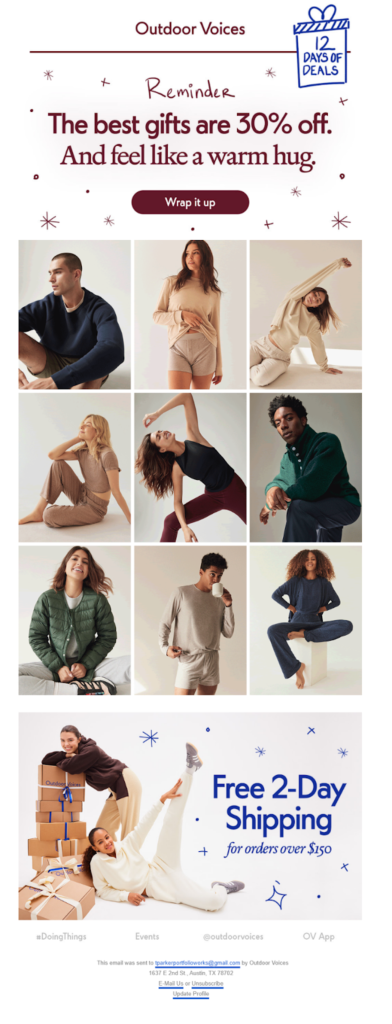
“30% off our top sellers – www.outdoor voices.com”
Opening the message with a 30% off deal and closing with a static image promising free 2-day shipping on orders over $150 gives subscribers all the information they need to recognize that Outdoor Voices can solve their last-minute gifting issues. No boring “shop now” CTA here, the button at the top invites clicks with the phrase, “wrap it up.”
📩 Staff favorite’s recommendations supported by personal testimonials from cosmetics and personal care brand, Violet Grey
The company’s staff selected the personal care products featured in this holiday gift guide email from glamor Violet Grey.
The copy promotes confidence and trust by emphasizing that staff members carefully vet every product the glamor brand sells to ensure that they meet the “Violet Code.”
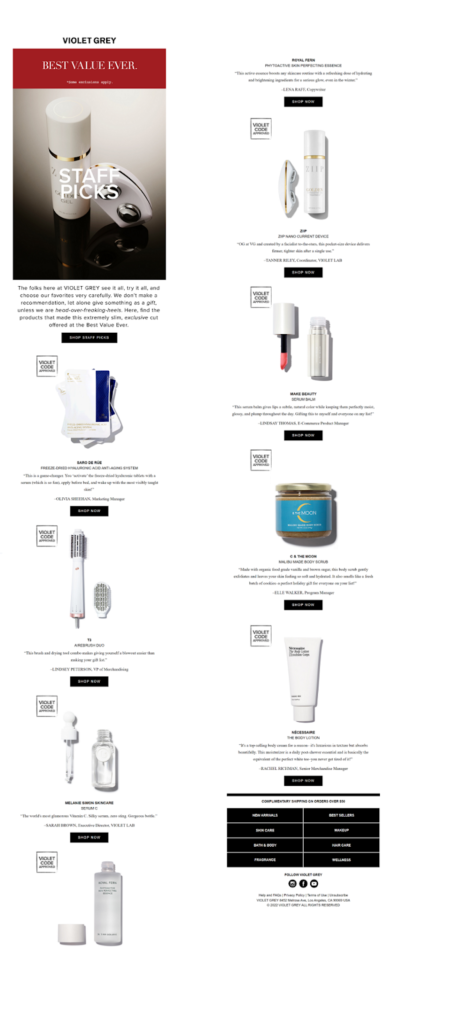
“To Gift or to Keep? – 25% off staff favorites”
A testimonial from the recommending staffer also accompanied each recommended item, “The world’s most glamorous Vitamin C. Silky serum, zero sting. Gorgeous bottle.” writes Sarah Brown, Violet Lab’s Executive Director about the Melanie Simon Skincare serum featured in the list.
Adding extra appeal for cost-sensitive subscribers, the email promises that the products that made the “exclusive cut” are being offered at the “Best Value Ever.”
📩 Brand-selected essentials recommendations to guide new subscribers in a welcome email from e.l.f. Cosmetics
Introducing a “starter pack” is a great way to familiarize new consumers with your brand. As part of its email subscriber onboarding sequence, E.l.f. Cosmetics sends an email that includes a list of basic make-up pieces and accessories.
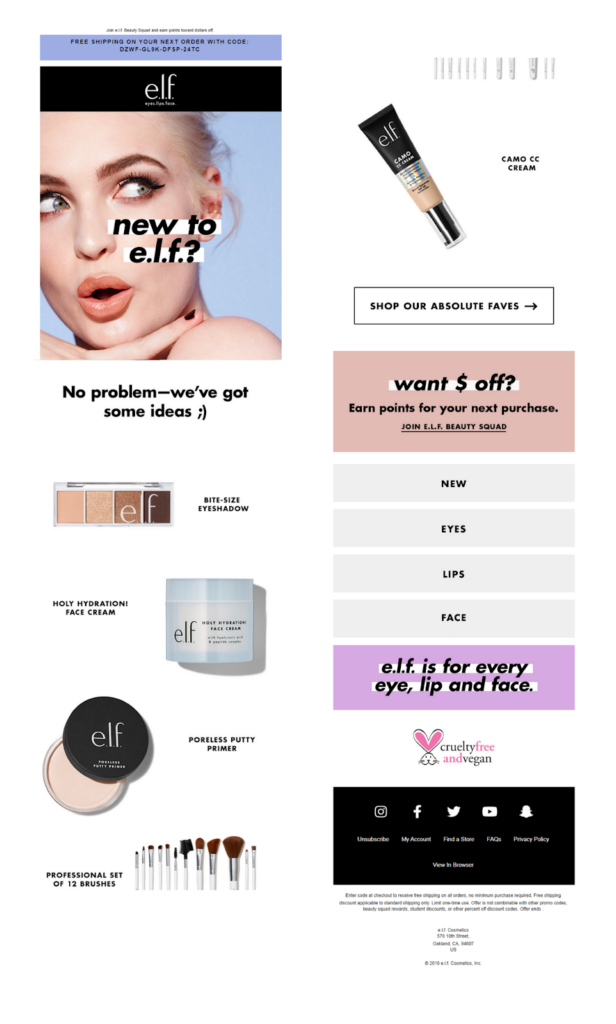
“Essentials that change the e.l.f.ing game – Join elf Beauty Squad and earn points toward dollars off.“
Adding to the appeal of this welcome message is an invitation to save by joining the brand’s rewards program and free shipping on the first purchase.
📩 Men’s clothing brand Rhone uses email recommendations to reduce decision paralysis and boost average order values
This promotional newsletter from Rhone features the brand’s classic clothes in top and bottom sets.

“Pair it With… – Everything is better as a pair.”
The recommended pairings help subscribers who might be thinking, “I like that shirt, but what will I wear it with?” It also encourages them to purchase multiple items from Rhone to mix and match for complete looks.
📩 A get-started guide recommending additional resources to new subscribers from B2B brand, Proofpoint
After subscribers sign-up to download gated content from threat protection provider Proofpoint, they receive a thank you email with their download links and a list of recommended resources to encourage them to continue their journey with this B2B brand.
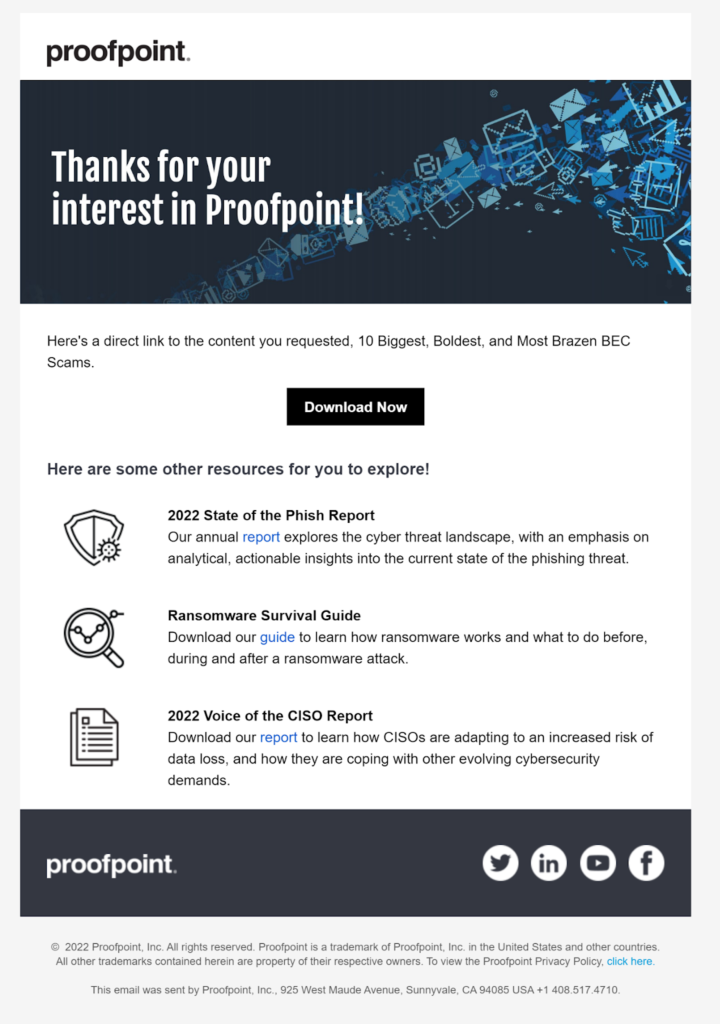
“Thanks for your interest in Proofpoint! – www.proofpoint.com”
📩 Popupsmart sends new subscribers a set of “getting to know us” resource recommendations
B2B marketing content provider Popupsmart also uses its first-touch email to introduce subscribers to the brand and its resources.
Its email delivers several categories of preset resources with recommendations drawn from the brand’s experience and include video setup guides for popular ecommerce platforms and answers to FAQs.

“[Name], a friendly welcome to Popupsmart ✨ Let’s get started! – Popupsmart.com”
📩 General “best-selling” recommendations in a targeted browse recovery message from Gemafina.
Responding to a subscriber who visited the website but didn’t make a purchase, Gemafina sends this transactional message that says, “Didn’t find what you were looking for? We’ve got some gorgeous (and best-selling!) suggestions that might be up your alley.”

“Didn’t quite find what you were looking for?”
The Gemafina email is populated with images of different types of jewelry inducing rings and necklaces in a variety of styles. The content isn’t personalized but might pique the interest of someone who will know what they want when they see it.
📩 Gardener’s Supply presents a revolving selection of recommendations to intrigue and engage new shoppers
After a new subscriber signs up and has a look around the Gardener’s Supply website, they’ll receive an email like the one below that features a collection of products.
Plot twist! Every time someone opens the email, the selections change. 👀
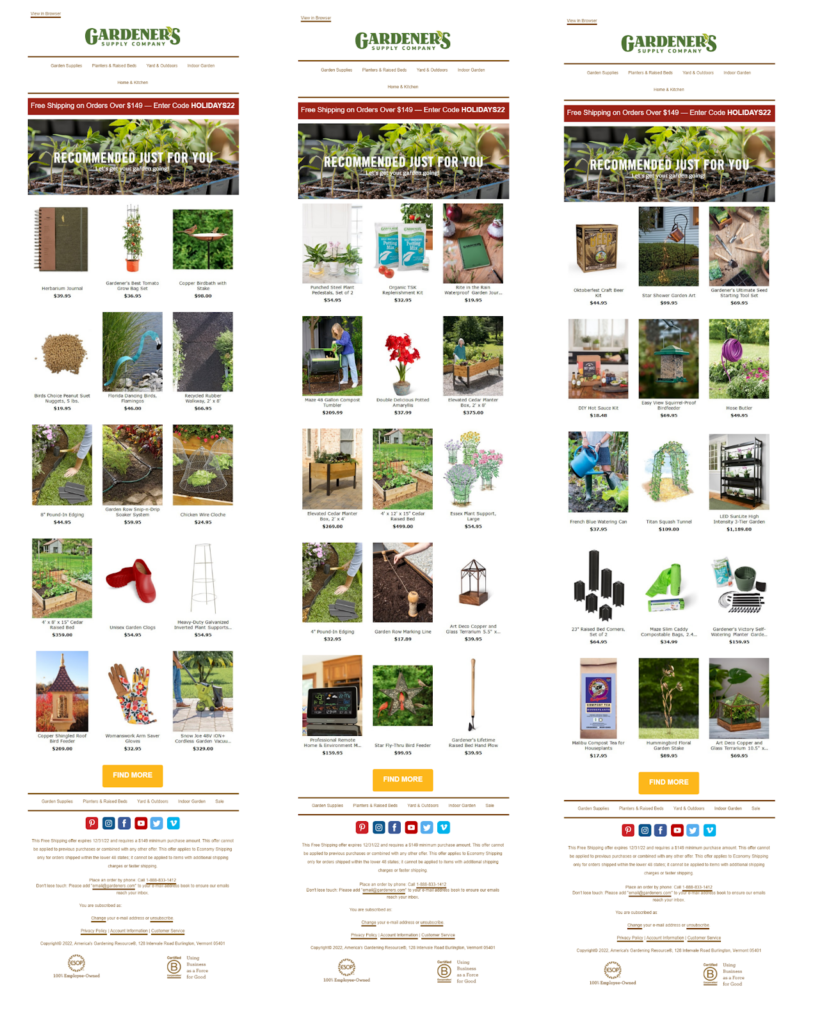
“Selected Just For You! – Plus, free shipping on orders over $25”
This dynamic presentation strategy works for the brand because all the products it offers are related. Any set of gardening related items is likely to contain something that interests subscribers. Showing people a range of products may help them find the items they didn’t know they wanted. The “serendipity” effect.
📩 A recovery drip campaign with recommendations two–ways from B2C brand Zulily
Using different formats or recommendation strategies in an abandoned browse, cart or checkout flow, like Zulily does in this recovery series displayed below, can maintain your subscribers’ interests and help you learn more about their preferences.
In the first email in the series, Zulily presents item- and category-related recommendations in response to the subscriber’s on-site behavior.
The first message responds directly to the subscriber’s search. The subject line and preview text, “Based on your search for “Tablecloth” – We have custom discoveries for you.” make the message’s purpose clear.

Inside, the copy invites the subscriber to “Complete the Search! Finding what you’re looking for is so satisfying. We’re here to help with these just-in wins.”
Late the same day, another email offers the subscriber a wider range of products and references different on-site behavior.
Using the subject line “We think you’ll love these,” this message presents a curated list of trending “top sellers” from the home goods category (where our subscriber had browsed earlier).
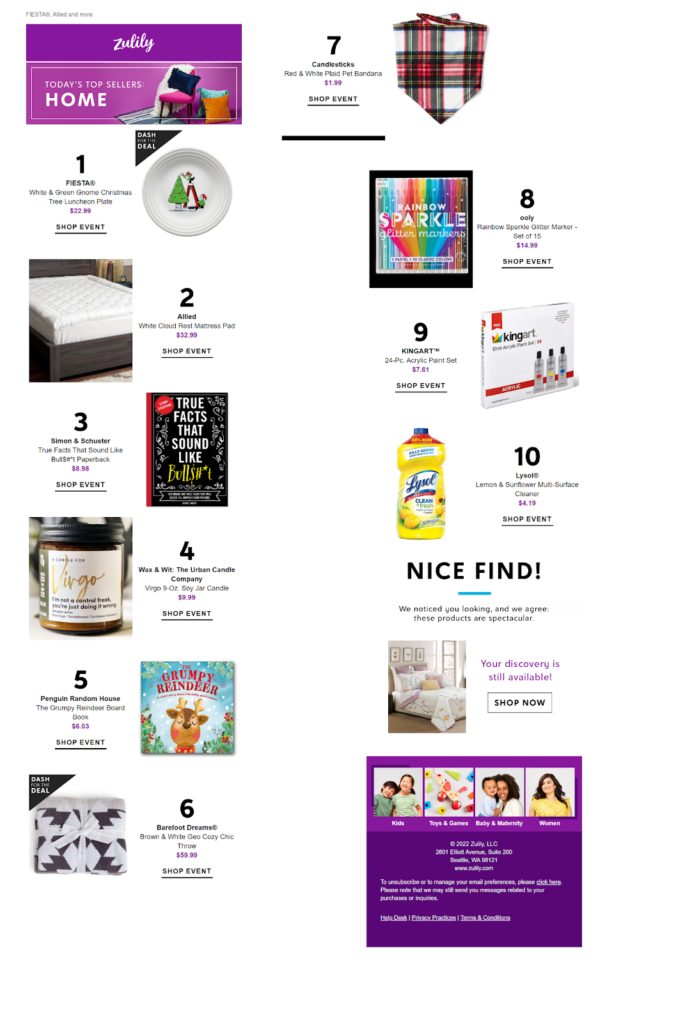
This email closes out with an image of a quilt the subscriber viewed under a subheading and copy that reads, “Nice Find! We noticed you looking, and we agree these products are spectacular.”
With little information to go on, Zulily has figured out that this subscriber is looking for home goods. Now the brand will have to wait to find out if its recommendations lead to a sale and more data.
📩 Ann Taylor bringing home the close with a “now on sale” and “you might also like” customized browse recovery email
Ann Taylor’s recommendation engine noticed this subscriber had a penchant for ponchos and delivered the goods in this targeted recovery email.

I’m a frequent admirer of Ann Taylor’s inbox copy and this email doesn’t disappoint.
“Remember This? It’s On Sale – Don’t Miss Out,” is the subject line preview text combo for the message. The copy is friendly and helpful with just a touch of urgency. If someone was hesitant to buy because of price, this subject line should make them want to open the message to see the deal.
The copy inside the message gets straight to the point, “Still love this look? The price just dropped!” And the CTA button text urges expediency, “Get it now.”
What’s all this fuss about copy? Once you get your subscribers’ attention, you don’t have much time to convince them to act. Optimize your chances of success with conversion-focused call-to-actions.
📩 Michaels offers product alternatives in a personalized cart recovery campaign
Online and offline craft retailer Michaels uses a customized appeal in this email triggered by a customer’s recent visit to the website.
The inbox display for this message opens with an emoji and notes that the email contains shopped for items and recommendations, “😍 You have Great Taste: We Reserved This for You! – Plus, shop fresh picked deals just for you!”
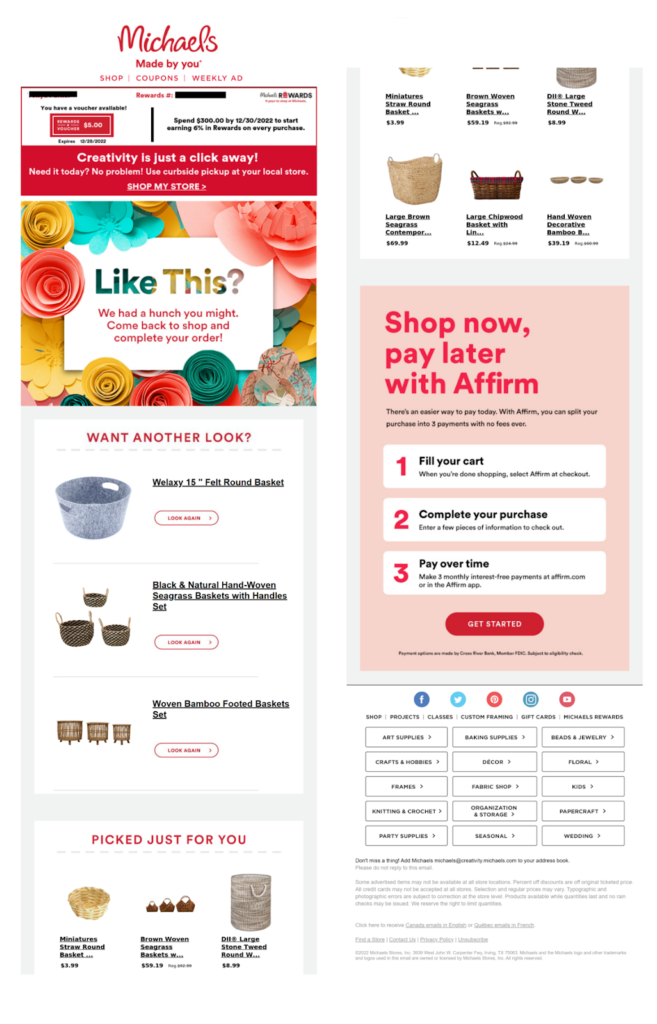
The body of the message employs dynamic content in several locations. The recipient’s name, rewards account number and rewards balance appear at the top of the email along with an invitation to “Come back to shop and complete your order!”
Images of the items the recipient viewed on the store’s website appear in a content block under the come back message. Then, the message presents related product recommendations in a separate “Picked Just For You” section.
This design puts the product suggestions in the prime central part of the email. Contrasting colors frame the product recommendations and guide the viewer toward the shop now, pay later promotion that precedes footer with social and navigational links.
📩 Customized cross-selling recommendations fill this post-purchase email from Wayfair
Once a customer has purchased from your brand, it’s time to get sticky with it. Send them a personalized message with suggestions of other items they might enjoy.

“[Name. we found items you will LOVE – shop handpicked finds that we know you’ll love.”
This email from Wayfair arrived after the recipient purchased a slow cooker from the ‘home interior and other stuff’ seller. Included in the recommendations are several items from the recipient’s browning history plus a few new suggestions.
📩 A custom-curated “discover more” message for business professionals from BrightTALK
Video hosting site BrightTalk sends subscribers customized viewing recommendations using their on-site behaviors and stated preferences. Subscribers can indicate their areas of interest and follow specific publishers on the website to narrow the topics that BrightTALK suggests.
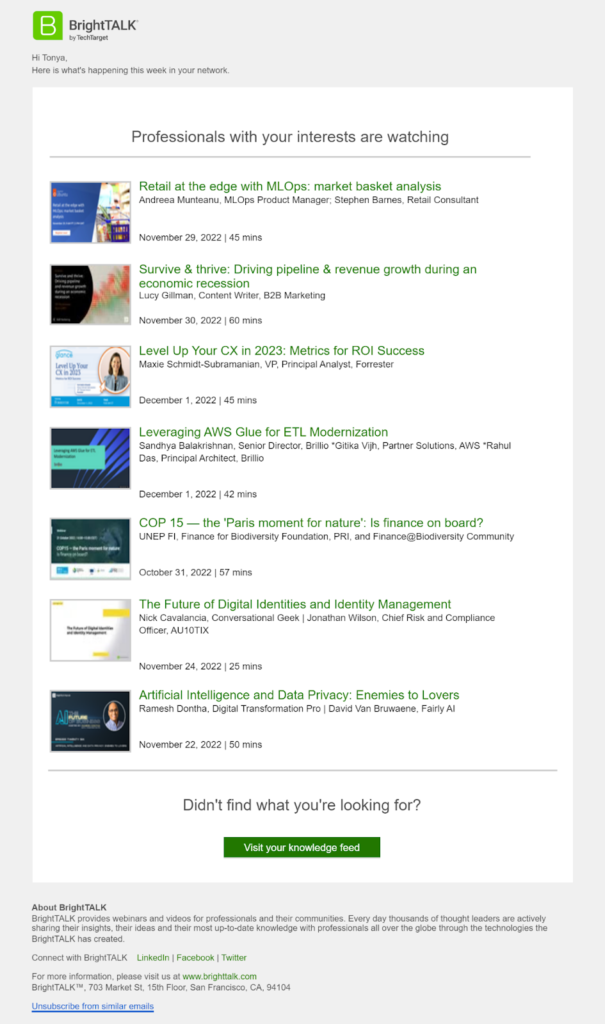
“Watch the latest recommendations from your network – Hi [Name], Here is what’s happening this week in your network.” (BrightTALK)
This email offers recipients a list of resources and includes a call to action that encourages them to explore further, “Didn’t find what you were looking for? Visit your knowledge feed.”
📩 Etsy maintains post-purchase momentum with targeted “new finds” emails
Online marketplace Etsy targets recent shoppers with follow-up emails that encourage them to come back and explore more products.

“Love this shop? You’ll love these finds ❤️️– All new and just for you.”
This simple email template keeps Etsy vendors in touch with their customers by showing them what’s new in stock.
Each product panel includes an image plus a description, pricing information and a ”shop now” CTA button. The content is customized using dynamic blocks so everyone’s message is one-of-a-kind.
📩 Targeted recommendations aimed at ensuring adoption and encouraging upgrades from research service provider, Owler
Personalized news aggregation service Owler delivers daily updates about the companies users follow. Subscribers can use the service for free but need to upgrade to follow more than a few companies.
Why would they want to do that? Owler demonstrates why by including a selection of news from “Recommended Companies” in each daily newsletter.

“Your Saturday morning update – News on WalkMe, Totango, NXP…”
Under the “Recommended Companies” header the copy invites action stating, “Like what you see? This group will change day-to-day, so be sure to follow companies that matter to you to receive regular updates.” “Learn more” is the key phrase in both the mid-copy text link and bottom- of-the-email button CTA.
📩 G2 aims to stimulate engagement with tailored recommendations in a personalized newsletter
Software information and review site G2 relies on customer reviews to keep its visitors informed. To encourage subscribers to participate, the brand sends a monthly recap that includes a summary of their activities on the site, links to new content, and a selection of “top picks” for each subscriber.

“Your November Digest – Activity Roundup l Exclusive Review Opportunities l Handpicked Articles“
The B2B recommendation email’s preview text notes the customized content.
Inside the message, customized recommendations include topics relevant to the subscribers’ profile or on-site search history, under the captions: “G2’s Top Picks for You” and “Handpicked articles we think you’ll enjoy.”
Like any marketing email, earning conversions starts with earning an open. To achieve inbox engagement, you’ll need a great subject line, like the ones in the next section.
30 click-worthy product recommendation email subject lines and preview text to use in your campaigns
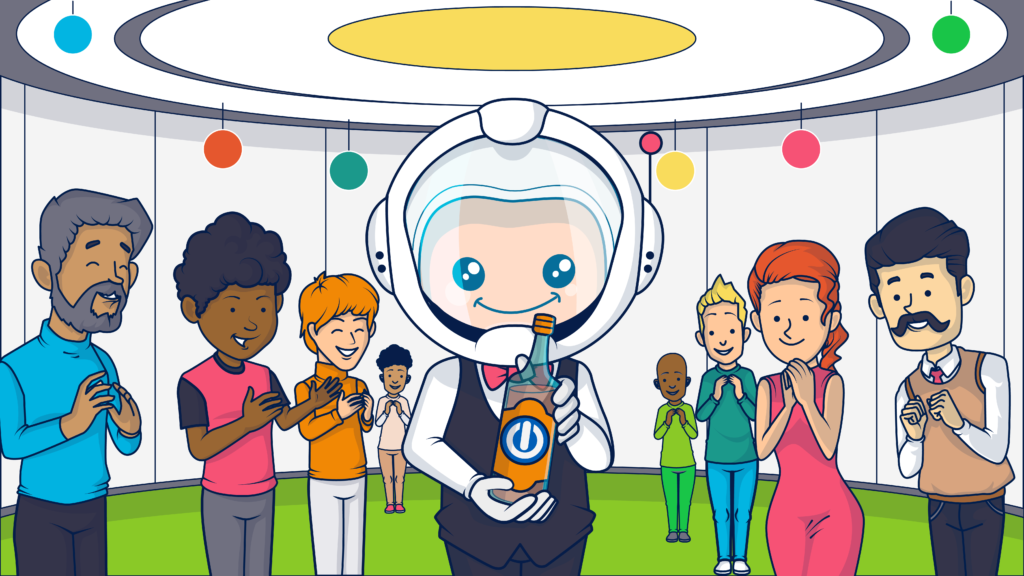
Grab attention in the inbox and build credibility with creative subject lines and preview text that explains the why behind your recommendations.
Engage persuasive devices such as social proof, urgency, authority or FOMO to instill confidence and encourage people to take the next step after viewing your message.
Here are some examples of subject line words and phrases that tell subscribers what to expect and why they should read your emails:
- New arrivals
- Selling fast
- Our top sellers
- Best-selling in [category]
- Other people bought
- Top rated
- Most viewed
- Inspired by [featured artist, season, mood] (e.g., “Inspired by the artistry of…”]
- Limited edition
- Celebrate [season or event] with these top picks
- Gifts for [group or segment] (e.g., “Gifts for Kids”)
- [Season or event] gift guide (e.g., Christmas gift guide]
- On sale now
- Our favorites
- Essentials
- Handpicked selections
- Recommended for you
- Items you’ll love
- Because you [liked, purchased, viewed]
- Similar to your wishlist
- You might also like
- From your network
- Didn’t find what you wanted? Try these instead.
- What we’re reading
- What we’re loving
- [Date or day] top 10 (e.g., “This week’s top 10”)
- What’s hot in [product category, topic, or location] (e.g., What’s hot in Denver this week)
- Discover the top [apps, downloads, products, resources, etc.]
- Shop the best finds
- New [item, resources, picks] for you
Use similar wording in your email body’s headers to keep the momentum going and don’t forget to add call-to-action copy that compliments your other content and encourages subscribers to take the next step.
Want to try something other than ‘Buy Now?’
Sample some of these email recommendation CTAs:
Buy these exclusives
Check it out
Complete my look
Discover my match
Explore our [holiday] shop
Explore the collection
Explore top picks
Find my match
Find related items
Find your faves
Get it now
Get mine
Get shopping
Get this pick
Get your faves
Grab this deal
I love it
I want it
Make it yours
More picks from [influencer]
Place my order
See more recommendations
See more staff picks
See what’s new
See what’s trending
Shop [category]
Shop [group or segment] best sellers
Shop [influencer]’s collection
Shop best finds
Shop best sellers
Shop gifts for [group or segment]
Shop the edit
Shop this set
Shop top recommendations
Shop top-rated
shop your faves
Show me more
Sign me up
Start gifting
View details
View more like this
View my picks
Take my advice, add recommendation emails to your campaign flows
Here are a few last pieces of advice for achieving increased engagement and conversions with recommendation emails:
- Even if your recommendations are objective-based, use data to guide your selections. Preserving your subscribers’ trust for the long-term is more important than winning a one-time conversion.
- Make product recommendation emails part of an omnichannel strategy that includes customized on-page recommendations for website visitors and personalized landing pages for your email campaigns.
- Deploy persuasive elements in your design and copy. Visually represent star-ratings next to recommended products and add customer testimonials. Create numbered lists that rank products, add real-time sales tickers or other interactive elements to your emails.
- Use high-quality images, animated GIFs or user generated content to show off your products and their features.
- Pair your product suggestions with incentives to buy such as discount offers and rewards points. Bundle related products and offer a deal on the set.
- Test the content and timing of your recommendation emails. When is the best time to send a recommendation message to your subscribers and what types of recommendations do they respond to best? Use A/B or multivariate testing to discover what works without slowing your email delivery schedule.
- Employ email workflows to ensure timely arrival of your email recommendations and set up multi-message flows that deliver recommendations as one part of a comprehensive, value-adding series.
- Follow best practices for formatting and coding your emails so they are mobile-friendly, accessible and deliver an outstanding experience every time.
If these recommendation email tips and examples have inspired you, then let me recommend a few more resources for you to explore.
See how other brands are presenting product suggestions in their regular and seasonal emails by checking out the examples in our other newsletter guides about Valentine’s Day and Mother’s Day.
We roam the web, mine Milled.com, and search our own inboxes for the best emails to sample so you don’t have to. 😉
And, if you haven’t already, subscribe to our blog so we can deliver more awesome advice straight to your inbox.

